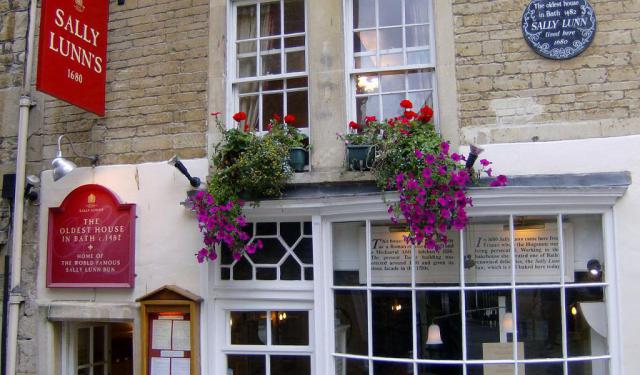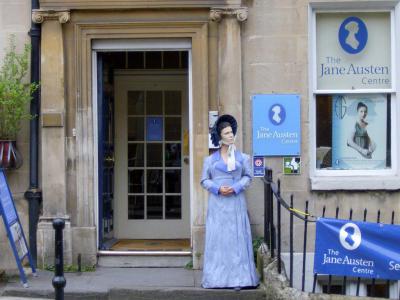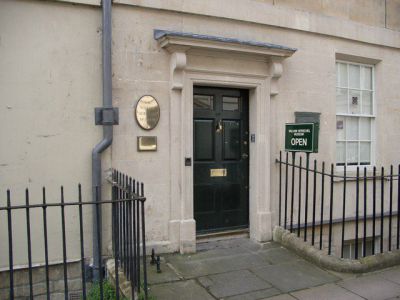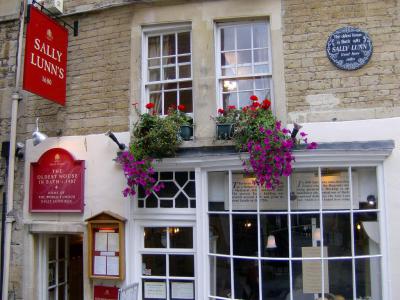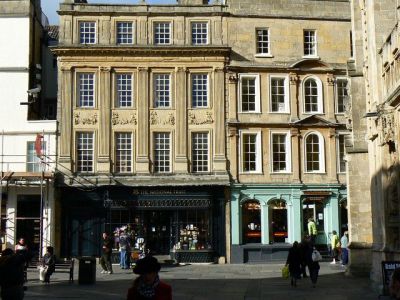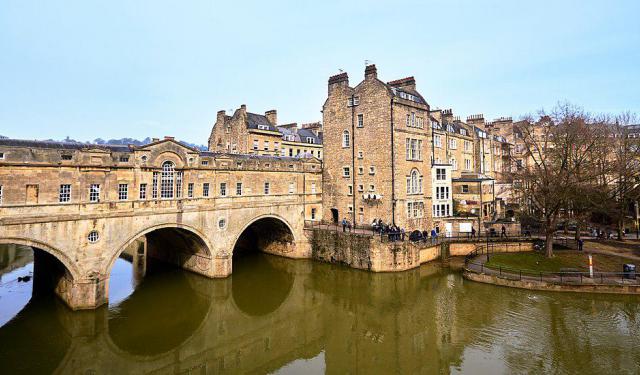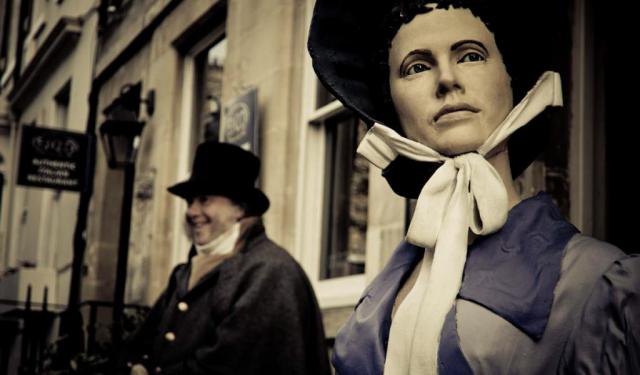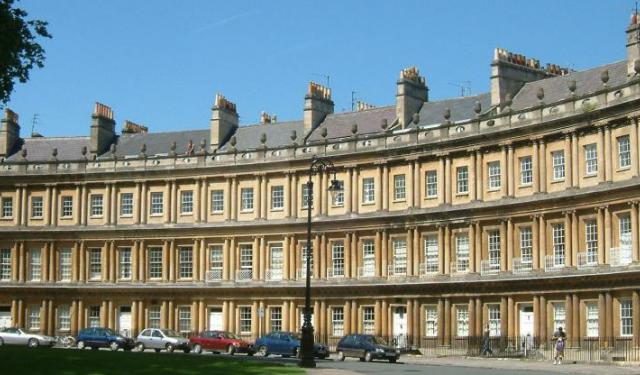Historical Homes Walking Tour (Self Guided), Bath
Apart from its Roman thermae, the city of Bath is renowned for its prominent residents who used to live here a long time ago. Their former dwellings – historical monuments in their own right – now offer a captivating glimpse into the city's glorious past.
Among the most famous of them, undoubtedly, is the Jane Austen Centre. This charming Georgian townhouse provides a fascinating look into the life and times of the renowned novelist Jane Austen, who called Bath home for a significant part of her life. Visitors can explore exhibits, period costumes, and even enjoy a cup of tea in the elegant Regency Tea Room.
Another notable historical location is the Herschel Museum of Astronomy. Located in the former home of William Herschel, a renowned astronomer, this museum showcases his groundbreaking discoveries, including that of the planet Uranus.
Those with a taste for culinary history should definitely drop in at Sally Lunn's Historic Eating House. This lovely 17th-century building is reputed to be the home of Sally Lunn, the inventor of the famous Sally Lunn Bun.
Marshal Wade's House, on the other hand, offers a glimpse into the military history of Bath. This grand Georgian house was once the residence of George Wade, the former Commander-in-Chief of the British Army in the mid-18th century.
Bath's historical homes are fit to satisfy a diverse range of interests, from literary and military history to astronomical discoveries and culinary delights. Together, they provide an enriching journey through time whereby one can get an idea of how people used to live here, back in the day. If you find this idea good for highlighting your trip to Bath, then take this self-guided walk!
Among the most famous of them, undoubtedly, is the Jane Austen Centre. This charming Georgian townhouse provides a fascinating look into the life and times of the renowned novelist Jane Austen, who called Bath home for a significant part of her life. Visitors can explore exhibits, period costumes, and even enjoy a cup of tea in the elegant Regency Tea Room.
Another notable historical location is the Herschel Museum of Astronomy. Located in the former home of William Herschel, a renowned astronomer, this museum showcases his groundbreaking discoveries, including that of the planet Uranus.
Those with a taste for culinary history should definitely drop in at Sally Lunn's Historic Eating House. This lovely 17th-century building is reputed to be the home of Sally Lunn, the inventor of the famous Sally Lunn Bun.
Marshal Wade's House, on the other hand, offers a glimpse into the military history of Bath. This grand Georgian house was once the residence of George Wade, the former Commander-in-Chief of the British Army in the mid-18th century.
Bath's historical homes are fit to satisfy a diverse range of interests, from literary and military history to astronomical discoveries and culinary delights. Together, they provide an enriching journey through time whereby one can get an idea of how people used to live here, back in the day. If you find this idea good for highlighting your trip to Bath, then take this self-guided walk!
How it works: Download the app "GPSmyCity: Walks in 1K+ Cities" from Apple App Store or Google Play Store to your mobile phone or tablet. The app turns your mobile device into a personal tour guide and its built-in GPS navigation functions guide you from one tour stop to next. The app works offline, so no data plan is needed when traveling abroad.
Historical Homes Walking Tour Map
Guide Name: Historical Homes Walking Tour
Guide Location: England » Bath (See other walking tours in Bath)
Guide Type: Self-guided Walking Tour (Sightseeing)
# of Attractions: 4
Tour Duration: 1 Hour(s)
Travel Distance: 1.6 Km or 1 Miles
Author: rose
Sight(s) Featured in This Guide:
Guide Location: England » Bath (See other walking tours in Bath)
Guide Type: Self-guided Walking Tour (Sightseeing)
# of Attractions: 4
Tour Duration: 1 Hour(s)
Travel Distance: 1.6 Km or 1 Miles
Author: rose
Sight(s) Featured in This Guide:
- Jane Austen Centre
- Herschel Museum of Astronomy
- Sally Lunn's Historic Eating House
- Marshal Wade's House
1) Jane Austen Centre (must see)
Nothing typifies Regency life in Bath so much as a classic Jane Austen novel. The world-renown author lived in Bath from 1801 to 1806. Two of her novels, Northanger Abbey and Persuasion, were set here. So it's no surprise that in Bath you will find the Jane Austen Centre. Nestled in a Georgian house near the imposing Bath Abbey, The Circus, and the Roman Baths, this museum aims to share the wonders of Austen's Georgian-era Bath with the world.
The Centre has actors in Regency costume to create an immersive experience. There is a carefully crafted, waxwork statue of Jane. The waxwork often surprises visitors as it stands at 5'8", quite tall for a Georgian lady. Forensic artists spent over three years creating the sculpture. There is only one likeness of Jane Austen; a portrait drawn by her sister, Cassandra. However, other family members criticized the portrait and felt it did not capture the true Jane Austen. See for yourself whether or not the sculpture matches your expectations. You'll also find a gift shop and a tea room operated by the Centre.
Why You Should Visit:
Ardent Jane Austen fans will need no encouragement to stop at the Jane Austen Centre. But the Centre is designed as an immersive experience for the whole family, with guides in period costumes add to the charm. Learn about Bath's history, especially about Regency-era life and customs.
The building itself, part of a block on Gay Street, is an English Heritage Grade II listed building.
Tips:
The Centre organizes Bath's Jane Austen Festival every year in September. The ten-day celebration features over 80 events, including a summer ball, a costumed promenade, and a masquerade ball.
Do not miss the Centre's Regency Tea Room, which has been awarded the Tea Guild's Award of Excellence. If you've visited the Centre, you get 10 percent off at the Tea Room.
The Centre has actors in Regency costume to create an immersive experience. There is a carefully crafted, waxwork statue of Jane. The waxwork often surprises visitors as it stands at 5'8", quite tall for a Georgian lady. Forensic artists spent over three years creating the sculpture. There is only one likeness of Jane Austen; a portrait drawn by her sister, Cassandra. However, other family members criticized the portrait and felt it did not capture the true Jane Austen. See for yourself whether or not the sculpture matches your expectations. You'll also find a gift shop and a tea room operated by the Centre.
Why You Should Visit:
Ardent Jane Austen fans will need no encouragement to stop at the Jane Austen Centre. But the Centre is designed as an immersive experience for the whole family, with guides in period costumes add to the charm. Learn about Bath's history, especially about Regency-era life and customs.
The building itself, part of a block on Gay Street, is an English Heritage Grade II listed building.
Tips:
The Centre organizes Bath's Jane Austen Festival every year in September. The ten-day celebration features over 80 events, including a summer ball, a costumed promenade, and a masquerade ball.
Do not miss the Centre's Regency Tea Room, which has been awarded the Tea Guild's Award of Excellence. If you've visited the Centre, you get 10 percent off at the Tea Room.
2) Herschel Museum of Astronomy (must see)
The Herschel Museum of Astronomy, located on New King Street in Bath, offers a rich historical and astronomical experience. Inaugurated in 1981, it occupies a well-preserved Georgian town house that once served as the home of the renowned astronomers William Herschel and his sister Caroline. This modest five-story building, part of a terrace constructed around 1764-1770, exemplifies middle-grade Georgian architecture with its Bath stone ashlar facade, slate Mansard roofs, and distinctive sash windows.
Significant for its connection to the Herschels, who resided here from 1777, the building is where William Herschel discovered Uranus in March 1781 using a telescope he designed and built on-site. Despite William's departure in 1782, Caroline and their brother Alexander remained until 1784.
Recognized for its historical importance, the building is a grade II* listed property by English Heritage. It underwent restoration in 1981 and again in 2000, featuring period-specific wallpaper and carpets based on 18th-century designs. The building's preservation was championed by the William Herschel Society, formed in 1977, and aided by Doctors Leslie and Elizabeth Hilliard, whose contributions are commemorated by the naming of asteroid 6395 Hilliard.
The museum, managed by the Herschel House Trust and governed by the Bath Preservation Trust since July 2015, was opened on the bicentennial of Uranus's discovery. Its patrons have included the notable astronomers Patrick Moore and Brian May. The museum is split over three floors within the house, with an ornamental garden attached, and a cinema within the vaults that shows documentaries on astronomical discoveries. Under the curatorship of Debbie James, the museum offers an engaging experience through audio tours, a virtual tour for mobility-impaired visitors, and tactile books for the visually impaired.
Significant for its connection to the Herschels, who resided here from 1777, the building is where William Herschel discovered Uranus in March 1781 using a telescope he designed and built on-site. Despite William's departure in 1782, Caroline and their brother Alexander remained until 1784.
Recognized for its historical importance, the building is a grade II* listed property by English Heritage. It underwent restoration in 1981 and again in 2000, featuring period-specific wallpaper and carpets based on 18th-century designs. The building's preservation was championed by the William Herschel Society, formed in 1977, and aided by Doctors Leslie and Elizabeth Hilliard, whose contributions are commemorated by the naming of asteroid 6395 Hilliard.
The museum, managed by the Herschel House Trust and governed by the Bath Preservation Trust since July 2015, was opened on the bicentennial of Uranus's discovery. Its patrons have included the notable astronomers Patrick Moore and Brian May. The museum is split over three floors within the house, with an ornamental garden attached, and a cinema within the vaults that shows documentaries on astronomical discoveries. Under the curatorship of Debbie James, the museum offers an engaging experience through audio tours, a virtual tour for mobility-impaired visitors, and tactile books for the visually impaired.
3) Sally Lunn's Historic Eating House
Inside one of the oldest houses in Bath, you will find some delectable treats. As the story goes, Sally Lunn was a French immigrant who arrived in Bath in 1680 and established this bakery. The house was built around 1482, but the masonry oven and other elements on the ground floor date from around 1137.
The lower level of the home hosts a museum where you can tour the original kitchen. The house still serves food based on their trademark recipe, the "Sally Lunn Bunn." In the evening, they serve fine English food, including some spectacular pies.
But all is not as it seems at Sally Lunn's Historic Eating House. While the food is excellent, and the house is very old indeed, there is little historical evidence of one Sally Lunn, or Solange Lyon, as the story goes. The building was purchased in the 1930s by the enterprising Marie Byng-Johnson, who opened a tearoom and claimed to subsequently discover an "ancient document" that told Madamoiselle Lunn's story. The "Sally Lunn Bunn" moniker had already long been used to describe the sweet teacake throughout Britain.
Regardless of the details, Sally Lunn Bunns are an iconic Bath original. There's no better place in town to take tea, and there's no better accompaniment than the original teacake. Savory or sweet, with tea or coffee, you can't go wrong. Just don't forget the clotted cream.
The lower level of the home hosts a museum where you can tour the original kitchen. The house still serves food based on their trademark recipe, the "Sally Lunn Bunn." In the evening, they serve fine English food, including some spectacular pies.
But all is not as it seems at Sally Lunn's Historic Eating House. While the food is excellent, and the house is very old indeed, there is little historical evidence of one Sally Lunn, or Solange Lyon, as the story goes. The building was purchased in the 1930s by the enterprising Marie Byng-Johnson, who opened a tearoom and claimed to subsequently discover an "ancient document" that told Madamoiselle Lunn's story. The "Sally Lunn Bunn" moniker had already long been used to describe the sweet teacake throughout Britain.
Regardless of the details, Sally Lunn Bunns are an iconic Bath original. There's no better place in town to take tea, and there's no better accompaniment than the original teacake. Savory or sweet, with tea or coffee, you can't go wrong. Just don't forget the clotted cream.
4) Marshal Wade's House
Marshal Wade's House, also known as General Wade's House, located on Abbey Church Yard in Bath, is a historical building of significant architectural and cultural value. Built around 1700, it has earned the prestigious status of a Grade I listed building, indicating its exceptional interest and national importance.
The house was initially believed to have been constructed in 1730 and attributed to Lord Burlington. However, further research has shifted this understanding, suggesting an earlier construction date. The actual patron of the house was George Wade, a notable figure in British military and political history. Wade was a Field Marshal, served as a British military commander and Commander-in-Chief of the Forces, and represented Bath as a Member of Parliament from 1722 to 1747.
Architecturally, Marshal Wade's House is a fine example of Palladian design, which is particularly evident in its façade. The building showcases five fluted Ionic pilasters across the first and second floors, embodying the elegance and symmetry characteristic of Palladian architecture. Additionally, the house features standard Georgian period sash windows with multiple panes and a moulded cornice. The design was inspired by Inigo Jones' house in Covent Garden, London, reflecting the influential styles of the time.
In the early 19th century, the ground floor of the building underwent a transformation. It was converted for retail use and now boasts a Regency era shopfront. This includes an elaborate fascia and delicate Regency trimmings, adding to the building's historical charm. Currently, this space is occupied by the National Trust. While the ground floor remains in retail use and is open to the public, the upper levels of the house are not accessible to visitors, preserving their historical ambiance.
The house was initially believed to have been constructed in 1730 and attributed to Lord Burlington. However, further research has shifted this understanding, suggesting an earlier construction date. The actual patron of the house was George Wade, a notable figure in British military and political history. Wade was a Field Marshal, served as a British military commander and Commander-in-Chief of the Forces, and represented Bath as a Member of Parliament from 1722 to 1747.
Architecturally, Marshal Wade's House is a fine example of Palladian design, which is particularly evident in its façade. The building showcases five fluted Ionic pilasters across the first and second floors, embodying the elegance and symmetry characteristic of Palladian architecture. Additionally, the house features standard Georgian period sash windows with multiple panes and a moulded cornice. The design was inspired by Inigo Jones' house in Covent Garden, London, reflecting the influential styles of the time.
In the early 19th century, the ground floor of the building underwent a transformation. It was converted for retail use and now boasts a Regency era shopfront. This includes an elaborate fascia and delicate Regency trimmings, adding to the building's historical charm. Currently, this space is occupied by the National Trust. While the ground floor remains in retail use and is open to the public, the upper levels of the house are not accessible to visitors, preserving their historical ambiance.
Walking Tours in Bath, England
Create Your Own Walk in Bath
Creating your own self-guided walk in Bath is easy and fun. Choose the city attractions that you want to see and a walk route map will be created just for you. You can even set your hotel as the start point of the walk.
Bath Introduction Walking Tour
The only English city designated a UNESCO World Heritage site, Bath is a gorgeous city packed with history. Artifacts have been found from the Bronze and Iron Age in the surrounding hills. The Romans were the first to build around the remarkable hot mineral springs at the beginning of the first century. They constructed a temple and baths here, and since then, people have flocked to Bath for its... view more
Tour Duration: 2 Hour(s)
Travel Distance: 2.5 Km or 1.6 Miles
Tour Duration: 2 Hour(s)
Travel Distance: 2.5 Km or 1.6 Miles
Jane Austen Walking Tour
Jane Austen, 1775-1817, was a renowned British author. Her groundbreaking novels offer a witty and humorous look at Regency-era life. Austen's six novels have since inspired many popular TV adaptations and films.
Jane Austen lived in Bath from 1801 to 1806. Two of her novels, Northanger Abbey and Persuasion, were set in this beautiful Georgian city. While interiors have certainly been... view more
Tour Duration: 2 Hour(s)
Travel Distance: 2.5 Km or 1.6 Miles
Jane Austen lived in Bath from 1801 to 1806. Two of her novels, Northanger Abbey and Persuasion, were set in this beautiful Georgian city. While interiors have certainly been... view more
Tour Duration: 2 Hour(s)
Travel Distance: 2.5 Km or 1.6 Miles
Georgian Architecture Walking Tour
Another prominent attraction of Bath is its wonderful Georgian architecture. Many a street and square here are richly adorned with distinctively stylish buildings. In large part, the city owes it to two architects – father and son: John Wood, the Elder, and John Wood, the Younger. Constructed mostly from Bath Stone, a creamy limestone obtained in Combe Down and Bathampton Down Miles, these... view more
Tour Duration: 1 Hour(s)
Travel Distance: 2.2 Km or 1.4 Miles
Tour Duration: 1 Hour(s)
Travel Distance: 2.2 Km or 1.4 Miles
The Most Popular Cities
/ view all
